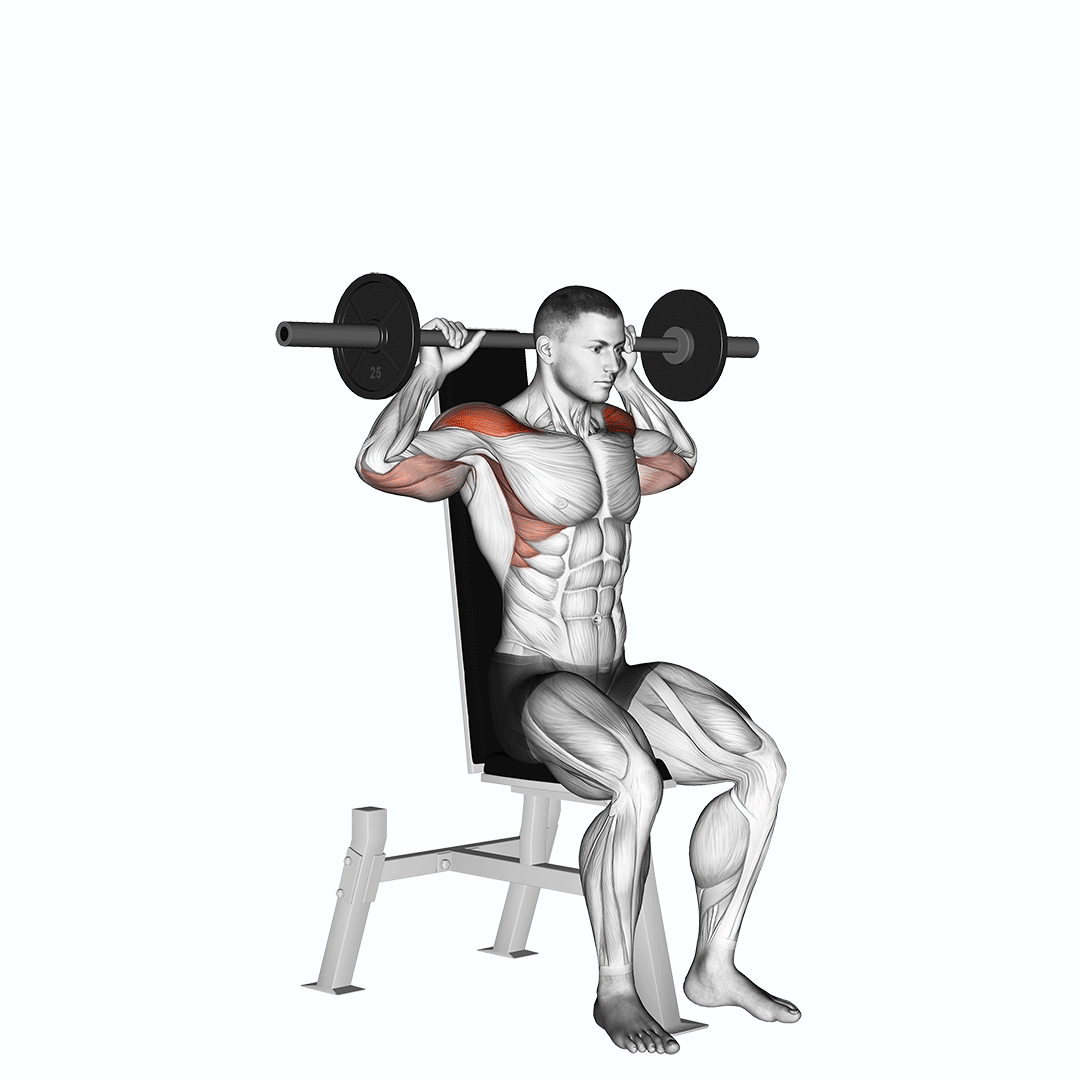The Barbell Seated Bradford Press builds shoulder strength and upper body stability. It works all three deltoid muscles (front, side, and back), as well as the triceps and upper back. This exercise improves shoulder endurance and builds balanced muscle for various activities.
Do this exercise two or three times a week, with a rest day between sessions. Keep your back straight and feet flat on the floor for stability. Start with a lighter weight to learn the movement, then increase the weight as you get stronger. Avoid using momentum or dropping your elbows too low. Controlled movements are important for safety and results. Use a barbell or dumbbells, whichever is more comfortable.
How to Do a Barbell Seated Bradford Rocky Press

Begin by sitting on a bench with your feet flat on the ground. Hold a barbell at shoulder height with both hands slightly wider than shoulder-width apart, palms facing forward.
- Start with the barbell at shoulder level, elbows below the bar.
- Press the barbell overhead until your arms are fully extended.
- Lower the barbell back to shoulder height, keeping your elbows out to the sides.
- Immediately press the barbell back overhead, maintaining a smooth motion.
- Repeat for the desired number of repetitions, ensuring controlled movement.
Inhale while lowering the barbell and exhale during the pressing phase for optimal breathing technique.
Level Up Your Fitness: Join our 💪 strong community in Fitness Volt Newsletter. Get daily inspiration, expert-backed workouts, nutrition tips, the latest in strength sports, and the support you need to reach your goals. Subscribe for free!
Common Mistakes
- Neglecting Proper Setup: Failing to stabilize your feet or having an improper grip can lead to inadequate support during the exercise. Ensure your feet are planted firmly on the ground and that your grip is secure to maintain control throughout.
- Inadequate Core Engagement: Many individuals forget to engage their core muscles, which can lead to instability and poor form. To avoid this, actively tighten your core throughout the movement, protecting your lower back and improving overall strength.
- Locking Elbows at the Top: Locking out your elbows can place undue stress on the joints and diminish the effectiveness of the exercise. Instead, maintain a slight bend in your elbows at the peak of the press to keep tension in your deltoids.
- Rushing Through Repetitions: Performing repetitions too quickly can lead to compromised form and increased risk of injury. Focus on a controlled, deliberate pace, ensuring that each movement is smooth and exact.
- Incorrect Position of Barbell: Allowing the barbell to drift too far forward or backward during the press can lead to shoulder strain. Keep the barbell in line with your shoulders throughout the movement to ensure optimal mechanics.
Benefits
- Enhances shoulder stability by engaging the deltoid muscles and surrounding stabilizers.
- Increases overall upper body strength, allowing for improved performance in various overhead lifts.
- Promotes better posture by activating the muscles that support the scapula and spine alignment.
- Improves muscular endurance in the shoulders, aiding in longer workout sessions without fatigue.
- Facilitates a full range of motion for the shoulders, helping to improve flexibility and mobility in daily activities.
Exercise Variations
Alternative Exercises
Safety Precautions
Before starting the Barbell Seated Bradford Press, it’s crucial to ensure that your setup is safe and effective. Always check that the bench is stable and securely positioned. A slippery or wobbly bench can lead to accidents, especially when lifting heavier weights. Furthermore, have a spotter present or use a power rack to provide support if you’re lifting heavy loads, as this can prevent injury in case of a drop.
Proper warm-up is essential to prepare your muscles and joints for the movement. Engage in dynamic stretches for the shoulders, upper back, and arms to enhance flexibility and reduce the risk of strain. Additionally, start with a lighter weight to master the technique before progressing to heavier weights. This approach allows your body to adapt and helps identify any form issues that may compromise your safety.
Maintain a stable and neutral spine throughout the exercise to prevent strain on your back. Avoid overarching or rounding your back by keeping your core engaged and your shoulder blades retracted. Finally, listen to your body: if you experience pain or discomfort that feels abnormal, stop the exercise immediately and reassess your form or consult a fitness professional.








